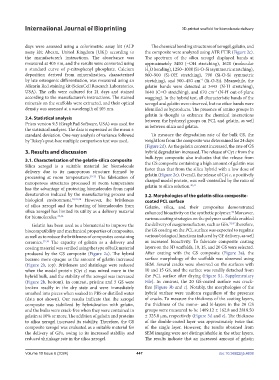Page 455 - IJB-10-6
P. 455
International Journal of Bioprinting 3D-printed scaffold for biomolecule delivery
days were assessed using a colorimetric assay kit (ALP The chemical bonding structures of xerogel, gelatin, and
assay kit; Abcam, United Kingdom [UK]) according to the composite were analyzed using ATR FTIR (Figure 2c).
the manufacturer’s instructions. The absorbance was The spectrum of the silica xerogel displayed bands at
measured at 405 nm, and the results were converted using approximately 3400 (−OH stretching), 1620 (molecular
a standard curve of p-nitrophenyl phosphate. Calcium H O bending), 1250–1000 (Si-O-Si asymmetric stretching),
2
deposition derived from mineralization, characterized 960–900 (Si-OH stretching), 790 (Si-O-Si symmetric
by late osteogenic differentiation, was measured using an stretching), and 500–450 cm (Si-O-Si). Meanwhile, the
−1
Alizarin Red staining kit (ScienCell Research Laboratories, gelatin bands were detected at 3443 (N-H stretching),
USA). The cells were cultured for 21 days and stained 1640 (C=O stretching), and 670 cm (N-H out-of-plane
−1
according to the manufacturer’s instructions. The stained wagging). In the hybrid test, all characteristic bands of the
minerals on the scaffolds were extracted, and their optical xerogel and gelatin were observed, but no other bands were
density was assessed at a wavelength of 405 nm. identified as byproducts. The presence of amino groups in
gelatin is thought to enhance the chemical interactions
2.4. Statistical analysis between the hydroxyl groups on PCL and gelatin, as well
Prism version 9.5 (GraphPad Software, USA) was used for as between silica and gelatin.
the statistical analyses. The data is expressed as the mean ±
standard deviation. One-way analysis of variance followed To measure the degradation rate of the bulk GS, the
by Tukey’s post-hoc multiple comparison test was used. weight loss from the composite was determined for 24 days
(Figure 2d). As the gelatin content increased, the rate of GS
3. Results and discussion hybrid degradation increased. The release of Cyt c from the
bulk-type composite also indicates that the release from
3.1. Characterization of the gelatin-silica composite the GS composite containing a high amount of gelatin was
Silica xerogel is a suitable material for biomolecule faster than that from the silica hybrid with a low dose of
delivery due to its nanoporous structure formed by
processing at room temperature. 29-32 The fabrication of gelatin (Figure 2e). Overall, the release of Cyt c, a positively
nanoporous structures processed at room temperature charged model protein, was well-controlled by the ratio of
40,41
has the advantage of protecting biomolecules from rapid gelatin to silica solution.
denaturation induced by the manufacturing process and 3.2. Morphologies of the gelatin-silica composite-
biological environment. 30,33,34 However, the brittleness coated PCL surface
of silica xerogel and the bursting of biomolecules from Gelatin, silica, and their composites demonstrated
silica xerogel has limited its utility as a delivery material enhanced bioactivity on the synthetic polymer. Moreover,
42
for biomolecules. 35,36 various coating strategies on the polymer scaffolds enabled
7,18
Gelatin has been used as a biomaterial to improve the the delivery of exogenous factors, such as GFs. Therefore,
biocompatibility and mechanical properties of composites, the GS coating on the PCL surface was expected to regulate
as well as to reduce the brittleness of composites containing various biological functions induced by GF delivery, as well
ceramics. 37-39 The capacity of gelatin as a delivery and as increased bioactivity. To fabricate composite coating
coating material was verified using the type of bulk material layers on the 3D scaffolds, 10, 15, and 20 GS were selected.
produced by the GS composite (Figure 2a). The hybrid After coating with the GS composite (Figure 3a), the
became more opaque as the amount of gelatin increased surface morphology of the scaffolds was observed using
(Figure 2b, top). Brittleness and shrinkage were reduced SEM. Several cracks were observed on the surfaces with
when the model protein (Cyt c) was mixed more in the 10 and 15 GS, and the surface was readily detached from
hybrid bulk, and the stability of the xerogel was increased the PCL surface after drying (Figure S1, Supplementary
(Figure 2b, bottom). In contrast, pristine and 5 GS were File). In contrast, the 20 GS-coated surface was crack-
broken readily in the dry state and were immediately free (Figure 3b and c). Notably, the morphologies of the
smashed into pieces when soaked in PBS or distilled water hybrid surface were uniform regardless of the presence
(data not shown). Our results indicate that the xerogel of cracks. To measure the thickness of the coating layers,
composite was stabilized by hybridization with gelatin, the thickness of the mono- and bi-layers in the 20 GS
and the bulks were crack-free when they were contained in groups were measured to be 1409.12 ± 162.8 and 2818.50
gelatin at 10% or more. The addition of gelatin and proteins ± 325.8 μm, respectively (Figure 3d and e). The thickness
to silica xerogel increased its stability. Therefore, the GS of the double-coated layer was approximately twice that
composite xerogel was evaluated as a suitable material for of the single layer. However, the results obtained from
the delivery of GFs, owing to its increased stability and SEM imaging were not distinguishable in the other layers.
reduced shrinkage rate in the silica xerogel. The results indicate that an increased amount of gelatin
Volume 10 Issue 6 (2024) 447 doi: 10.36922/ijb.4638

